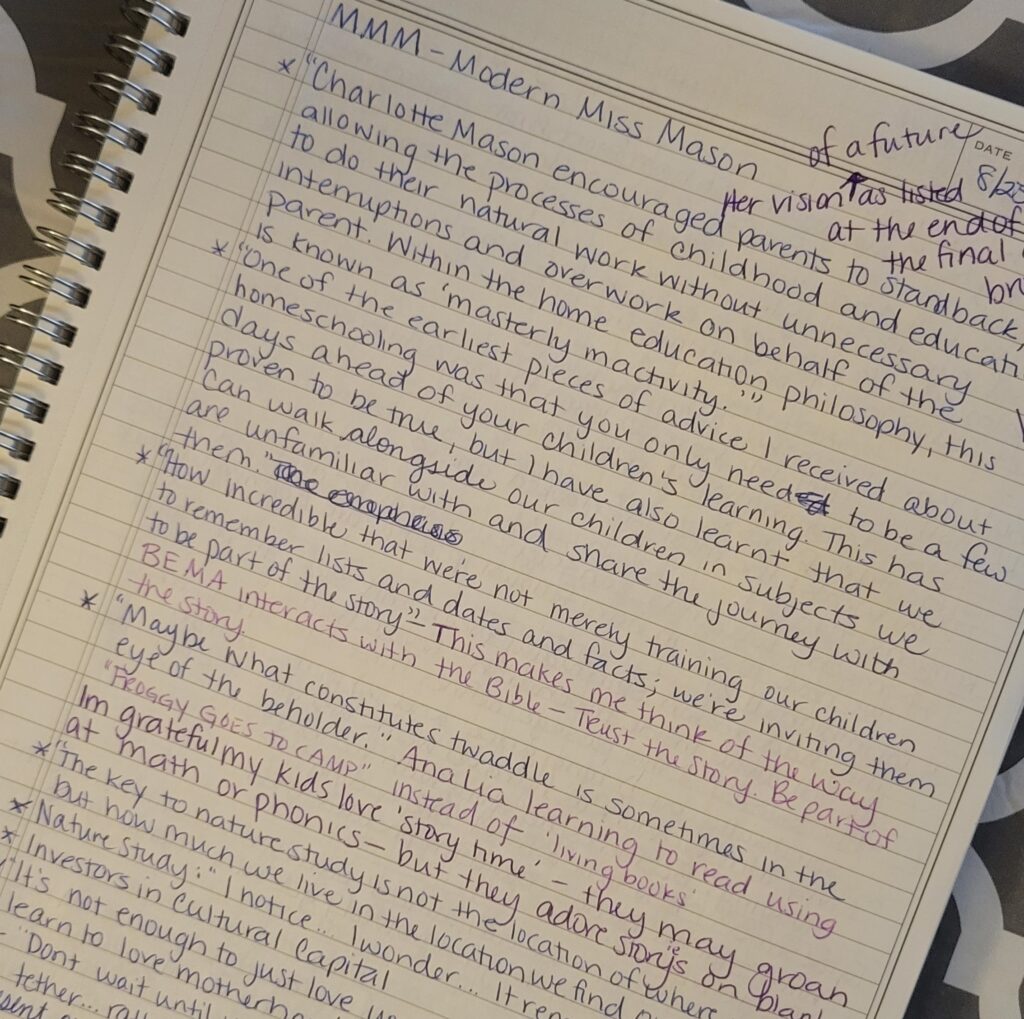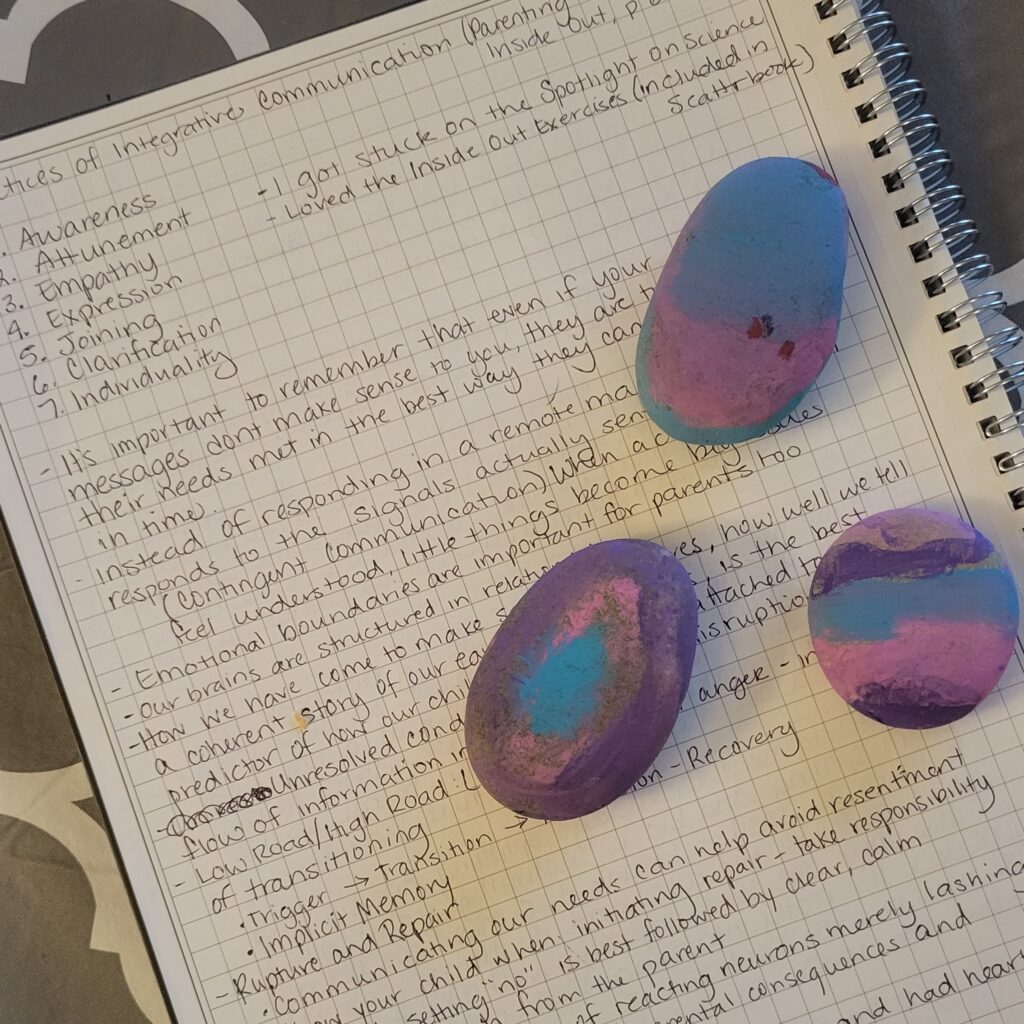I read The Brave Learner in 2021, and I have returned to it many times since. One of the recommendations I chose not to implement until years afterwards was the Scatterbook. It was one of the two ways that the author recommended keeping records of your homeschool. The Scatterbook was intended to be a place where you could add thoughts from the day, reflections on your homeschool, copy important quotations from books or lessons you heard. In many ways, my blog operates as a sort of Scatterbook for me. I keep book reviews, homeschool thoughts, and reflections on motherhood here. Looking back at posts I wrote years ago helps me see how far we have come, and in some areas, how far I have left to go. And this was one of the main reasons I told myself I didn’t need a Scatterbook – I already had my own version.
I reread The Brave Learner over our summer break this year in preparation for my first year homeschooling two separate grades and in preparation for using Emerging Writers as our main language arts curriculum this year. As I read through the section on keeping records, including the Scatterbook and the monthly narrative, I started to reconsider my earlier dismissal of the idea. While I did have my own version, my posts here are planned, written, edited, and for public consumption. There are many ideas, especially about my kids, that are not appropriate for sharing, and many of my thoughts do not make it through the planning and editing process. A Scatterbook was a place I could privately record these parts of our life and homeschool.
The other attraction of the Scatterbook was its analog design. By no means a Luddite as I work from home every day and integrate technology into many parts of our lives, I have made a more intentional effort to move away from my phone and laptop when possible. I love our Libby App for borrowing audiobooks from the library, but I have stopped reading the e-books on the app when I can get a physical book from the library instead. (This requires patience as it’s likely a week before my hold will come in rather than the seconds it takes to download the e-book, but that’s undoubtedly good for me too.) This way the kids can see that I’m reading instead of simply more time on my phone. I have done the same with my Bible reading, and having a physical notebook as my Scatterbook offered one more way for me to lean into a less digital life.

After walking through the benefits of keeping a Scatterbook, I came upon the largest obstacle, which upon reflection, was one of the biggest reasons I didn’t start one after my first time through The Brave Learner. The descriptions in the book provide an image of something beautiful and wonderful. In my mind, this was a scrapbook with all the trimmings and trappings of cutting, pasting, and finding photographs. I knew there was no way for me to maintain that level of commitment to a book, even if I managed to start; so I simply never started.
At the beginning of this school year, I wanted to do a better job keeping records of what we were learning. I purchased a fancy homeschool planner and started “planning from behind,” but even as I started, I knew it wasn’t a habit I was going to keep up with. I had a hard to time figuring out how to keep the different plans for each child and how to differentiate where each of them was inside the lesson or the plan. We returned to our visual calendar that helps the kids know how many subjects we have left for the day, and everyone was a little happier.
I also started reading some posts about the ways that other moms use Scatterbooks. The most impactful response was one that said, “I buy a cheap notebook so that I don’t feel any pressure to write ‘perfect’ things in it the way that I would if I had a beautiful, expensive one.” That sentence removed so much of the mental pressure that I had created around the Scatterbook. It did not have to be picture perfect, include elaborate scrapbook creations, or have any pictures at all. Other moms talked about how they used it for friends’ kids to doodle in, keep grocery lists, and other random thoughts.
I only needed a cheap notebook and a pen. I dug one out of the kids’ school supply drawers and began writing in it immediately.

A few months in, the practice of using my Scatterbook has helped my mental load tremendously. We have had several challenges and setbacks in our homeschool this year that I cannot widely share but still weighed on my heart. I took them to God in prayer, but writing them out line by line helped me understand which parts were problems for which I needed to find solutions and which parts were fear overtaking my thinking. I’ve been able to record changes in curriculum that I made over the first few months, which are decisions I have made in the past and simply moved on from. However, this allows me a record of those decisions so that I can go back later to determine what directions may work in the future.
I also love that my kids see me writing in a notebook. Even if I am creatively writing on my laptop, that does not look any different to them than when I am doing work for my job. When I pull out my notebook and start writing, it provides them with an example of adults writing. Being an example to our kids of good habits is always going to be more effective than telling them what they should be doing, even more effective than training them in the same. The simple act of sitting down and writing in my notebook encourages them to follow suit. I don’t expect that much of their writing throughout their lives is likely to be on pen and paper. I type exponentially faster than I write, but they are in a stage right now where all their writing is done with pen and paper. This new endeavor allows me to join them.
The maxim ‘Nothing avails but perfection’ may be spelt shorter: ‘Paralysis.’
WINSTON CHURCHILL, The Second World War, Volume IV: The Hinge of Fate
It was humbling to realize that fear of failure kept me from a practice that has added joy to my life. The idea that “perfection is the enemy of progress” became so real here. When I was eventually able to start, I started small with a few entries, including one explaining why it had taken me so long to start. I have not included any pictures yet, and maybe that will never be part of my practice. I don’t write in it every day, which also removes additional mental pressure. I use Scatterbook prompts from Brave Learner, allowing me to connect to other moms on similar journeys.
It only took a small step to add a little joy to my life, but it took a large leap overcoming my fear of imperfection.